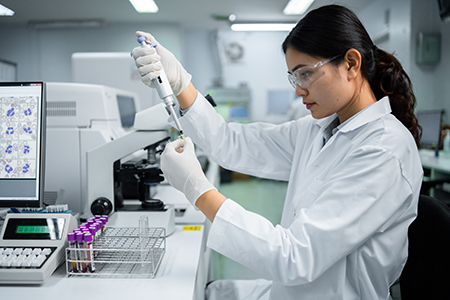Pap Tests: Why They’re so Important for Women's Health

Although pap tests might be uncomfortable and inconvenient, routine cervical screening can detect cervical changes before they become more serious. According to the Centers for Disease Control and Prevention (CDC), cancer is the second leading cause of death in the United States. One of every five deaths in the United States is due to cancer ¹.
It is critical to detect cancer when it is most treatable. Routine screening methods, like pap tests, can help detect cancer even before symptoms develop. Let’s learn more about pap tests and how they can help you stay healthy.
What is a pap test?
A pap test- also called a Papanicolaou test, cervical smear, or pap smear- is a screening method that can detect precancerous or cancerous changes in the cervix. A small number of cells are collected from the cervix and examined for abnormalities.
If abnormal cells are detected, more invasive diagnostic tests can be performed and your healthcare provider can begin your treatment. In most cases, treatment can prevent cervical cancer from developing ².
Who needs a pap test?
Women should start getting pap tests at age 21. For most women with normal results, pap tests can be repeated every 3 years. Women over 30 should discuss screening options with their healthcare provider. If HPV testing is done alongside a pap test, most patients can wait 5 years before repeating the test.
Many factors can affect frequency, such as whether or not there was an abnormal result in the past. However, for most women with a history of normal results, pap tests can be repeated every 3-5 years ².
What is HNL Lab Medicine’s role?
 When cells are collected as part of a pelvic exam or pap test, they are sent to HNL Lab Medicine for examination. First, the specimen is screened using Hologic’s imaging technology. Then, licensed cytologists and board-certified pathologists use will review the cells under a microscope and look for abnormalities.
When cells are collected as part of a pelvic exam or pap test, they are sent to HNL Lab Medicine for examination. First, the specimen is screened using Hologic’s imaging technology. Then, licensed cytologists and board-certified pathologists use will review the cells under a microscope and look for abnormalities.
Abnormal results means that cell changes were detected. While serious changes may be cancerous or precancerous, not all cell changes indicate cancer. Minor cell changes are often caused by HPV and can go back to normal on their own. However, more invasive testing may be needed to diagnose the cause of cell changes and to definitively rule out cervical cancer.
The results found by an HNL Lab Medicine clinician, which are sent to your physician, will help you make important medical decisions. Using this information, physicians can determine the frequency of your pap tests and whether or not you need more invasive testing.
Preventing cervical cancer
One of the best things you can do to lower your risk of cervical cancer is to get regular pap tests. Cervical cancer screening methods, like the pap test, detect nearly 200,000 cases of cervical precancer each year ⁴. Since these changes do not usually cause symptoms, the only way to discover them is through a pap test.
Almost all cases of cervical cancer are caused by HPV, which is a sexually transmitted infection that nearly 90% of people get at some point in their lifetimes ³. Almost all cervical cancer can be prevented by HPV vaccination ⁴. For recommended populations, like people between ages 9-26, the HPV vaccine can help prevent HPV-related cancers, including:
- Cervical, vaginal, and vulvar cancers
- Anal cancer
- Cancer of the back of the throat
- Genital warts
This vaccine protects against nine different types of HPV. HPV vaccines are also approved for individuals up to age 45 with certain risk factors. Talk to your healthcare provider to find out if the HPV vaccine is right for you.
For more information
Although cervical cancer was once the leading cause of cancer deaths among women in the United States, routine cervical cancer screening tests, like the pap test, and HPV vaccines have made it one of the most preventable cancers ⁴. As almost all cervical cancer is caused by HPV, getting an HPV vaccination can drastically reduce your chances of developing cervical cancer. For more information, visit the CDC or discuss these topics with your healthcare provider during your next visit.
REFERENCES
¹ Centers for Disease Control and Prevention. (2022, November). Cancer statistics at a glance. U.S. Department of Health and Human Services. https://gis.cdc.gov/Cancer/USCS/#/AtAGlance/.
² Centers for Disease Control and Prevention. (2022, December 14). What should I know about screening? U.S. Department of Health and Human Services. https://www.cdc.gov/cancer/cervical/basic_info/screening.htm.
³ Centers for Disease Control and Prevention. (2022, December 14). What are the risk factors for cervical cancer? U.S. Department of Health and Human Services. https://www.cdc.gov/cancer/cervical/basic_info/risk_factors.htm.
⁴ Centers for Disease Control and Prevention. (2022, February 28). Cancers caused by HPV. U.S. Department of Health and Human Services. https://www.cdc.gov/hpv/parents/cancer.html.